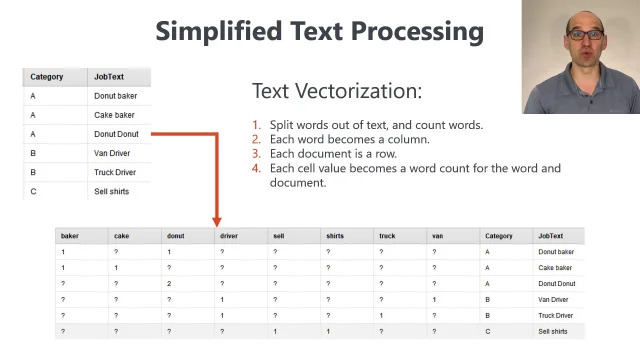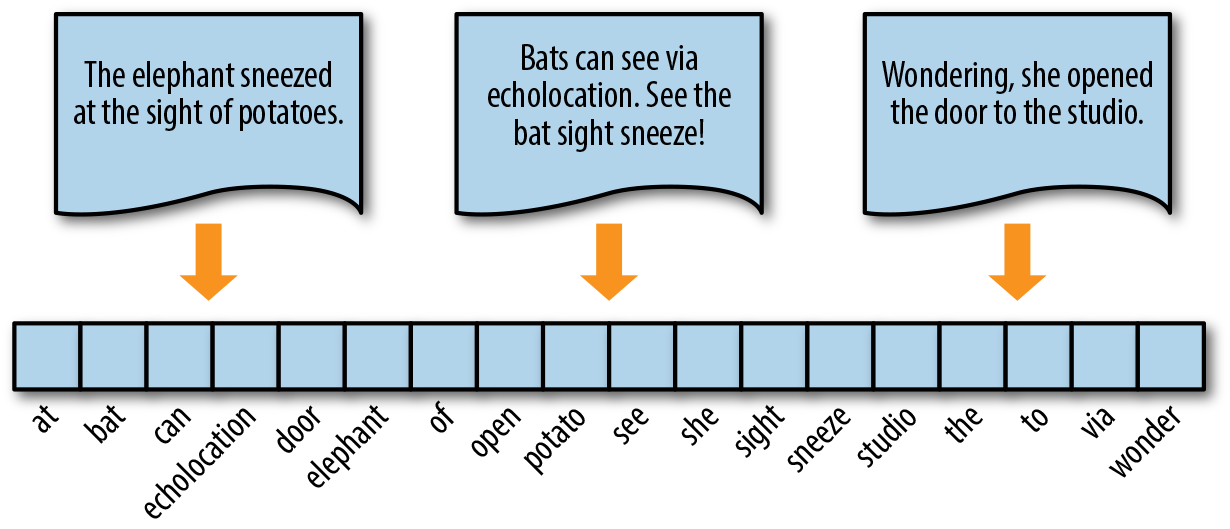
Text vectorization is the process of converting text into a numerical representation. This is useful for many natural language processing (NLP) tasks, such as machine translation, text classification, and question answering.
Vectors are a mathematical object that can represent a point in space. Each dimension of the vector represents a different property of the object. For example, a vector could be used to represent the location of a point on a map, where the x-dimension represents the longitude and the y-dimension represents the latitude.
In text vectorization, each word in a text is represented by a vector. The dimensions of the vector can represent different properties of the word, such as its frequency in the text, its meaning, and its relationship to other words.
There are many different ways to vectorize text. Some common methods include:
- Bag-of-words (BoW): In BoW, each word is represented by a binary vector, where each dimension represents the presence or absence of the word in the text.
- Term frequency-inverse document frequency (TF-IDF): TF-IDF is a weighted version of BoW, where the weight of each word is determined by its frequency in the text and its frequency across all documents in the corpus.
- Word embeddings: Word embeddings are a more sophisticated way to vectorize text. They represent each word by a vector of real numbers, where the dimensions of the vector capture the meaning and relationships between words.
Once text has been vectorized, it can be used as input to a variety of NLP models. For example, a machine translation model could use word embeddings to represent the words in the input sentence and the output sentence. The model could then learn to translate the input sentence to the output sentence by finding the corresponding word embeddings in the two languages.
Why is Text Vectorization Important?
Text vectorization is important because it allows us to use computers to process and understand text. Computers can only work with numbers, so text must be converted into a numerical representation before it can be used by a machine learning model.
Text vectorization also allows us to capture the meaning and relationships between words. This is important for many NLP tasks, such as machine translation and text classification. For example, a machine translation model needs to be able to understand the meaning of words in order to translate them accurately.
Applications of Text Vectorization
Text vectorization is used in a variety of NLP applications, including:
- Machine translation: Text vectorization is used in machine translation to represent the words in the input sentence and the output sentence. The model can then learn to translate the input sentence to the output sentence by finding the corresponding word embeddings in the two languages.
- Text classification: Text vectorization is used in text classification to represent the words in a text document. The model can then learn to classify the document into a category, such as "spam" or "not spam."
- Question answering: Text vectorization is used in question answering to represent the words in the question and the words in the document that contains the answer. The model can then learn to find the answer to the question by finding the words in the document that are most similar to the words in the question.
- Recommendation systems: Text vectorization is used in recommendation systems to represent the words in the items that a user has interacted with and the words in the items that the system is recommending. The system can then recommend items that are most similar to the items that the user has interacted with in the past.
How to Implement Text Vectorization in Python
There are a number of Python libraries that can be used to implement text vectorization. Some popular options include:
- scikit-learn: scikit-learn is a popular machine learning library that includes a number of text vectorization methods, such as CountVectorizer and TfidfVectorizer.
- gensim: gensim is a Python library for natural language processing. It includes a number of word embedding models, such as Word2Vec and FastText.
- spaCy: spaCy is a Python library for natural language processing. It includes a number of text vectorization methods, as well as other NLP features such as tokenization, part-of-speech tagging, and named entity recognition.
To implement text vectorization in Python, you will first need to choose a text vectorization method. Once you have chosen a method, you can use it to vectorize your text data.
The following code shows how to vectorize text data using the
WebThis post will walk you through the basics of text vectorization which is converting text to vectors (list of numbers). In this post, we present Bag of Words (BOW). WebIn the current era of natural language processing (NLP) increasingly relying on deep learning models that generate amazing performances, we have often overlooked. Webtf.errors. tf.estimator. tf.experimental. tf.feature_column. tf.graph_util. tf.image. tf.io. tf.keras. A preprocessing layer which maps text features to integer sequences. WebIn other words, the first step is to vectorize text by creating a map from words or n-grams to a vector space. The researcher fits a model to that DTM. These models.
Basic Text Vectorization | RapidMiner Studio

Source: academy.rapidminer.com
4. Text Vectorization and Transformation Pipelines – Applied Text Analysis with Python [Book]

Source: oreilly.com
Vectorization Techniques in NLP [Guide]

Source: neptune.ai
What Is Text Vectorization, Vectoring Words (Word Embeddings) – Computerphile, 23.25 MB, 16:56, 238,492, Computerphile, 2019-10-23T16:55:15.000000Z, 2, Basic Text Vectorization | RapidMiner Studio, academy.rapidminer.com, 360 x 640, jpg, , 3, what-is-text-vectorization
What Is Text Vectorization.
How do you represent a word in AI? Rob Miles reveals how words can be formed from multi-dimensional vectors – with some unexpected results.
08:06 – Yes, it’s a rubber egg 🙂
Unicorn AI:
EXTRA BITS: youtu.be/usthqKtw2LA
AI YouTube Comments: youtu.be/XyMdpcAPnZc
More from Rob Miles: bit.ly/Rob_Miles_YouTube
Thanks to Nottingham Hackspace for providing the filming location: bit.ly/notthack
facebook.com/computerphile
twitter.com/computer_phile
This video was filmed and edited by Sean Riley.
Computer Science at the University of Nottingham: bit.ly/nottscomputer
Computerphile is a sister project to Brady Haran’s Numberphile. More at bradyharan.com
Basic Text Vectorization | RapidMiner Studio
What Is Text Vectorization, WebIn other words, the first step is to vectorize text by creating a map from words or n-grams to a vector space. The researcher fits a model to that DTM. These models.
Vectoring Words (Word Embeddings) – Computerphile

Source: Youtube.com
Text Vectorization NLP | Vectorization using Python | Bag Of Words | Machine Learning

Source: Youtube.com
t-is-text-vectorizationWhat Is Text Vectorization? Everything You Need to Know – deepset
In natural language processing (NLP), we often talk about text vectorization — representing words, sentences, or even larger units of text as vectors (or “vector embeddings”). Other data types, like images, sound, and videos, may be encoded as vectors as well. But what exactly are those vectors, and how can you use them in your own applications? .
.
What is text vectorization and how does it work.
What is text vectorization and how does it work
What is text vectorization and how does it work What is text vectorization.
What is text vectorization
What is text vectorization What is text vectorization and how does it work.
.
.
.
.
.
.
ginners-guide-textThe Beginner’s Guide to Text Vectorization – MonkeyLearn
The Beginner’s Guide to Text Vectorization Since the beginning of the brief history of Natural Language Processing (NLP), there has been the need to transform text into something a machine can understand. That is, transforming text into a meaningful vector (or array) of numbers. .
log › 2021Text Vectorization and Word Embedding | Guide to Master NLP …
To convert the text data into numerical data, we need some smart ways which are known as vectorization, or in the NLP world, it is known as Word embeddings. Therefore, Vectorization or word embedding is the process of converting text data to numerical vectors. Later those vectors are used to build various machine learning models. .
derstanding-nlp-wordUnderstanding NLP Word Embeddings — Text Vectorization
Processing natural language text and extract useful information from the given word, a sentence using machine learning and deep learning techniques requires the string/text needs to be converted into a set of real numbers (a vector) — Word Embeddings. .
tting-started-with-textGetting Started with Text Vectorization | by Shirley Chen …
Text Vectorization is the process of converting text into numerical representation. Here is some popular methods to accomplish text vectorization: Binary Term Frequency Bag of Words (BoW) Term Frequency (L1) Normalized Term Frequency (L2) Normalized TF-IDF Word2Vec .
0 Comments